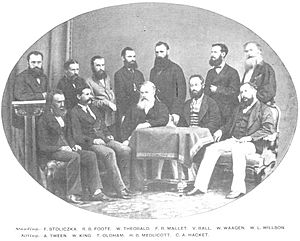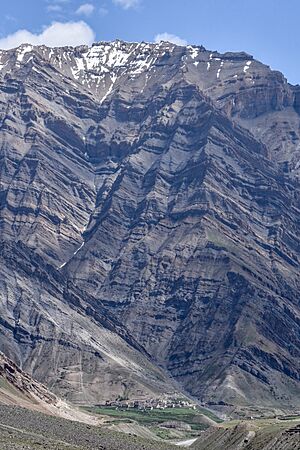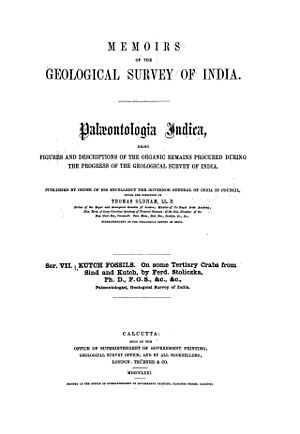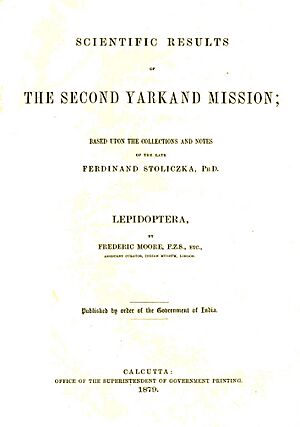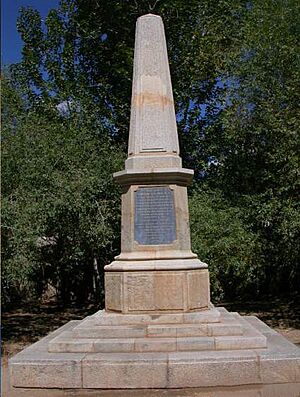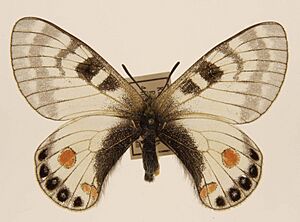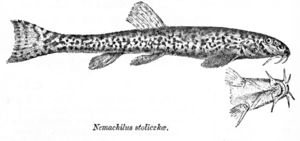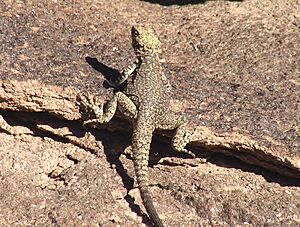Ferdinand Stoliczka facts for kids
Quick facts for kids
Ferdinand Stoliczka
|
|
|---|---|
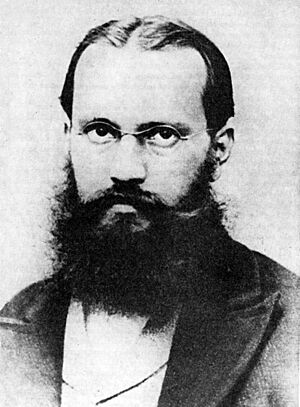 |
|
| Born | 7 June 1838 |
| Died | 19 June 1874 (aged 36) |
| Alma mater | Charles University |
Ferdinand Stoliczka (in Czech, Stolička; June 7, 1838 – June 19, 1874) was a brilliant scientist from Moravia, a region now part of the Czech Republic. He worked in India as a palaeontologist, studying ancient life forms. He also focused on geology (the study of Earth's rocks) and many areas of zoology (the study of animals).
Stoliczka was especially interested in ornithology (birds), malacology (mollusks), and herpetology (reptiles and amphibians). Sadly, he died from high altitude sickness during an important expedition across the Himalayas.
Contents
Early Life and Education
Ferdinand Stoliczka was born on June 7, 1838, near Kroměříž in Moravia. His father was a forester, managing the lands of the Archbishop of Olomouc. Ferdinand attended a German secondary school in Kroměříž.
Even though he was Czech, Stoliczka wrote all his 79 scientific articles in German. He likely spoke German at home. Later, when he lived in Calcutta, India, he was an important member of the German-speaking community there.
Stoliczka studied geology and palaeontology at Prague and the University of Vienna. He learned from famous professors like Eduard Suess. He earned his Ph.D. from the University of Tübingen in 1861. His first studies were about ancient freshwater mollusca (snails and clams) found in the Alps.
Career in India
In 1862, Stoliczka joined the Geological Survey of India (GSI). This was a British government organization in India. Dr. Thomas Oldham recruited him for this important role.
In Calcutta, Stoliczka's main job was to study and describe Cretaceous fossils from southern India. He published his findings in a major scientific work called Palaeontologia indica. He worked on this project with another scientist, William Thomas Blanford.
By 1873, this huge project was finished. It included four large books with nearly 1500 pages and 178 detailed drawings. One of his discoveries was a fossil frog from the Deccan Traps near Bombay.
Stoliczka also explored the Himalayas and Tibet, studying their geology. He wrote many papers on various topics, including Indian zoology. For a short time in 1868, he was a curator at the Indian Museum. He also helped manage the journal of the Asiatic Society of Bengal.
Expeditions and Discoveries
Stoliczka traveled a lot during his career. He visited Burma, Malaya, and Singapore. He also made two trips to the Andaman and Nicobar Islands. Another important trip was to the Rann of Kutch.
His first trip to the Himalayas was in 1864. In 1865, he returned to the Ladakh Valley with an artist friend and a dog. During his visit to Kutch in 1871–1872, he saw wild cheetahs. He also observed what is now known as Stoliczka's bushchat, a type of bird.
In 1873, he joined an expedition to the Andaman and Nicobar islands. This trip was organized by Allan Octavian Hume.
The Last Expedition
Stoliczka's third and final expedition was his most famous. It took place from 1873 to 1874. This was during a time known as the "Great Game," a rivalry between the British and Russian empires. Eastern Turkestan (Kashgaria) was a very important area.
The British sent a diplomatic mission, called the Second Yarkand Mission, to meet Yakub Beg, the ruler of Chinese Turkestan. Stoliczka joined this mission as the naturalist. The mission was huge, with 350 support staff and 550 animals. It also needed thousands of porters and horses.
The mission started from Rawalpindi and traveled through the Himalayas. They went past Pangong Lake and the Karakash Valley. They finally reached Yarkand and then Kashgar in December 1873.
On March 17, 1874, they began their journey back. They had planned to visit the Pamir and Afghanistan, but political problems prevented it. They returned to India through Ladakh.
On June 16, 1874, Stoliczka suffered severe headaches. This happened as they crossed the Karakoram Pass, which is very high (5580 meters or about 18,300 feet). That night, he wrote about the rocks he wanted to explore.
Captain Trotter reported that Stoliczka went out to examine rocks on June 18. He returned tired and complained of a headache. He had trouble breathing and coughed all night. The doctor diagnosed him with acute bronchitis and lung inflammation. Stoliczka passed away quietly on June 19, 1874.
Stoliczka died at Murgo in Ladakh. His last wish was for Allan Octavian Hume to publish his bird observations from the expedition. This work was eventually finished by Richard Bowdler-Sharpe years later.
A granite monument stands in his memory at the Moravian mission cemetery in Leh. An obituary, a notice of his death, was published in the scientific journal Nature.
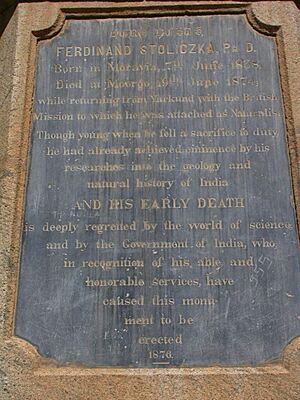
The monument reads:
FERDINAND STOLICZKA, Ph D. Born in Moravia 7th June 1838
1876
Died at Moorgo 19th June 1874
while returning from Yarkund with the British
Mission to which he was attached as Naturalist.
Though young when he fell a sacrifice to duty,
he had already achieved eminence by his
researches into the geology and
natural history of India
AND HIS EARLY DEATH
is deeply regretted by the world of science
and by the Government of India, who
in recognition of his able and
honourable services, have
caused this monu-
ment to be
erected
Ornithological Contributions
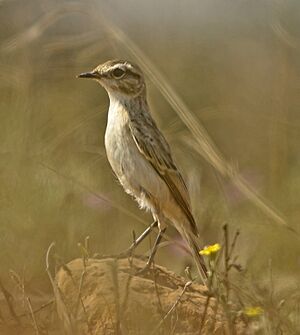
Stoliczka became interested in birds in 1864, during his time in the Himalayas. He was greatly encouraged by Allan Octavian Hume, who is known as the "father of Indian Ornithology." Stoliczka's first work on birds involved collecting many bird specimens from the Sutlej Valley.
Arthur Viscount Walden, another bird expert, praised Stoliczka's work. He recognized Stoliczka as an important scientific ornithologist. However, Walden disagreed with Stoliczka about naming new species based on small differences in their feathers.
Hume supported Stoliczka and wrote an article in the journal Ibis. He argued against "cabinet naturalists" in London who didn't know much about India's geography. Soon after, Hume started his own journal, Stray Feathers, to encourage ornithologists in India to publish their findings.
Some of the new bird species Stoliczka identified were later found to have been described already. A Russian zoologist named N. A. Severtzov had named them earlier.
Stoliczka's bird publications include:
- Stoliczka, F. (1873): Letters to the Editor. Stray Feathers. 1(5):425-427.
- Stoliczka, F. (1874): Letters to the Editor. Stray Feathers. 2(4&5):461-463.
- Stoliczka, F. (1874): Letters to the Editor. Stray Feathers. 2(4&5):463-465.
- Stoliczka, F. (1875): The avifauna of Kashgar in winter. Stray Feathers. 3(1,2&3):215-220.
- Stoliczka, F. (1872): Notice of the mammals and birds inhabiting Kachh [Cutch]. Jour. Asiatic Soc. Bengal 41(2):211-258.
- Stoliczka, F. (1868): Ornithological observations in the Sutlej valley, N.W. Himalayas. Jour. Asiatic Soc. Bengal 37(2):1-70.
Herpetological Contributions
In the scientific field of herpetology, Stoliczka described many new species of amphibians and reptiles. Several species and even a genus (a group of related species) have been named in his honor by other herpetologists.
Taxa Described by Stoliczka
- See Category:Taxa named by Ferdinand Stoliczka for a list of species he named.
Species Named After Stoliczka
Many animals have been named after Ferdinand Stoliczka to honor his work. Here are some examples:
Animals Named in His Honor
- The ammonite genus Stoliczkaia (an ancient sea creature).
Spiders
- Stoliczka's crab spider, Thomisus stoliczka
- The nursery web spider genus Stoliczka
Birds
- Stoliczka's treecreeper, Certhia nipalensis
- Stoliczka's bushchat, Saxicola macrorhyncha
Fish
- Stoliczka's loach, Triplophysa stoliczkai
- Stoliczka's barb, Pethia stoliczkana
Insects
- Ladakh banded apollo butterfly, Parnassius stoliczkanus
- Orange clouded yellow butterfly, Colias stoliczkana
Mammals
- Stoliczka's trident bat, Aselliscus stoliczkanus
- Stoliczka's mountain vole, Alticola stoliczkanus
Reptiles
- Mongolia rock agama, Paralaudakia stoliczkana
- The snake genus Stoliczkia
- Stoliczka's tawny cat snake, Boiga ochracea stoliczkae
- Stoliczka's stripe-necked snake, Liopeltis stoliczkae
- Frontier bow-fingered gecko, Altiphylax stoliczkai
- Paraxenodermus borneensis, also known as the Borneo red snake or Stolickza's stream snake.
See also
- Stoliczka Island (Остров Столичка)


